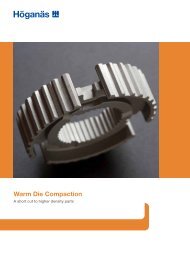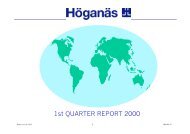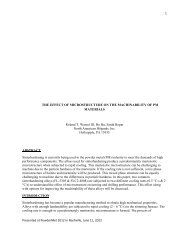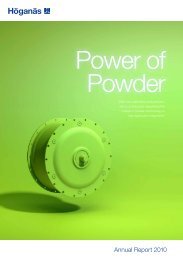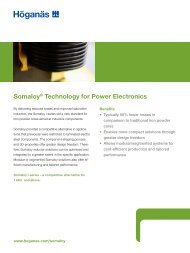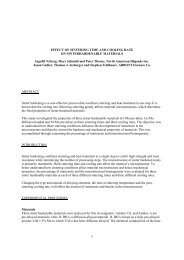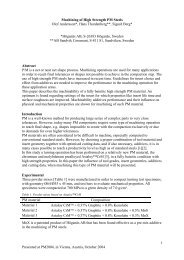Read article - Höganäs AB
Read article - Höganäs AB
Read article - Höganäs AB
- TAGS
- article
- www.hoganas.com
You also want an ePaper? Increase the reach of your titles
YUMPU automatically turns print PDFs into web optimized ePapers that Google loves.
ZaKo3D – Simulation Possibilities for PM Gears<br />
Christian Brecher, Christof Gorgels, Philipp Kauffmann, Tobias Röthlingshöfer<br />
Laboratory for Machine Tools and Production Engineering<br />
RWTH Aachen University<br />
Anders Flodin, Jannik Henser<br />
<strong>Höganäs</strong> <strong>AB</strong><br />
1 Abstract<br />
Powder metal technology is an alternative manufacturing method for the series-production of<br />
gears. But the properties of PM and regular steel gears differ. Especially the values for<br />
Young’s Modulus, Poisson’s Ratio and the hardness are smaller, the surface is densified and<br />
the tolerance zone is wider. Since PM gears are not state of the art yet, the properties for<br />
these gears are not taken into account by regular tooth contact analysis software.<br />
In order to design gears for the manufacturing with PM technology which will show good<br />
noise and bearing behaviour, the design has to be tested by tooth contact analysis software<br />
that takes the PM characteristics into account. This paper shows the program ZaKo3D of<br />
WZL which is able to take the characteristics into account using a FE-based approach. Using<br />
ZaKo3D a case study for the design of the micro geometry of an automotive PM gear was<br />
carried out. This study, including the PM gear modelling, the sensitivity analysis and the derivation<br />
of flank modifications is presented in the paper.<br />
2 Description of ZaKo3D<br />
The general approach of ZaKo3D is the software based simulation of the tooth contact. Input<br />
data are geometric data of the flank and a FE-model of a gear section. Furthermore the input<br />
data at the top of Figure 1 (pitch and assembly deviations) can be considered. During the<br />
simulation the contact distances, loads and deflections on the tooth are calculated. The results<br />
of the calculation can be displayed in established diagrams to support the gear designer<br />
during the developing process.<br />
Input<br />
Output<br />
Tooth Flank Topography<br />
Ease-Off Contact Pattern,<br />
Single und<br />
Multiple Mesh<br />
Contact<br />
Flankentopografie<br />
Pitch Deviation<br />
F p fΣβ<br />
Transmission Error,<br />
with and without load<br />
Pitch<br />
Excitaion Behaviour<br />
Fourier Spectra<br />
Axial Positioning<br />
3D Tooth Contact Analysis<br />
3D Tooth Contact Analysis<br />
Figure 1: Features of the 3D Tooth Contact Analysis ZaKo3D<br />
e<br />
f Σσ<br />
f a<br />
Stresses<br />
Bearing Capacity<br />
Presented at World PM2010 Powder Metallurgy World Congress & Exhibition, in Florens, Italy on October 12, 2010<br />
© WZL
The operation sequence of ZaKo3D is displayed in Figure 2. At the beginning the flank geometry<br />
has to be provided. This can for example be done by a manufacturing simulation or<br />
by measurement. The flank is defined by points in Cartesian coordinates and the direction of<br />
the normal vectors in each flank point.<br />
In order to be able to simulate under load, FE-data has to be generated out of the flank data.<br />
The FE-model contains the information about the stiffness of the gear. It is created by an<br />
automatic FE-mesh generator for gear teeth [1]. Additional to the flank geometry information<br />
about the distribution of FE-nodes inside the model and the material properties are needed.<br />
Each point of the modelled flanks is loaded with unit forces in each, x-, y- and z-direction.<br />
Using this model a standard FE-solver is used to calculate so called influence coefficients.<br />
The influence coefficients hold the information about the deflection of all points during the<br />
application of each unit force. This contains the displacement influence coefficients αii which<br />
are on the diagonal of the influence coefficient matrix as well as the cross influence coefficients<br />
αij. To complete the input data, information about the positioning of the gears is<br />
needed. ZaKo 3D supports the positioning of different gear types, containing e.g. spur gears,<br />
bevel gears and beveloid gears.<br />
Manufacturing Simulation/Gear Measuring Grid/Contour of Tooth Gap<br />
Displacement Influence Coefficients FE-Structure Generation<br />
F Nx<br />
F Nz<br />
F Ny<br />
F Nz<br />
F Ny FNx<br />
Mathematic Spring Model Transmission Error, Contact Pattern …<br />
Fres F Nz<br />
FNx FNy Figure 2: Operation Sequence for the Loaded 3D-Tooth Contact Analysis<br />
© WZL<br />
The input of pitch deviations, micro geometry deviations and corrections, assembly deviations<br />
or different loads can be done by the user and is optional.<br />
After reading in the input data the tooth contact analysis starts with the calculation of the contact<br />
distances of the flanks during the mesh. This is done for the given number of rolling positions<br />
and for each flank point of all the flanks that are in contact. With these contact distances<br />
and the information about the stiffness from the influence coefficients a mathematic<br />
spring model is defined [2]. Since the number of contact points in a rolling position and the<br />
force at each contact point influence each other it is necessary to solve the spring model iteratively.<br />
Out of this calculations the contact pattern and the transmission error can be derived load<br />
free and under load. The transmission error of a gear is caused by geometric errors of the<br />
flanks (load free content) and deflections (load content) of the gear, and gives a good impression<br />
of the dynamic gear excitation [3]. The course of the transmission error can be displayed<br />
over time and, by performing a Fast-Fourier-Transformation, in the frequency domain.<br />
Using the forces on the nodes and the flank area this force is applied to, the resulting pressure<br />
can be calculated. The flank area corresponding to a node is defined by the grid size<br />
[2]. The surface stress distribution on the flank has a big influence on the wear resistance of<br />
Presented at World PM2010 Powder Metallurgy World Congress & Exhibition, in Florens, Italy on October 12, 2010
the flanks and a reduction can lower the risk of pitting appearance and improve the flank<br />
bearing capacity. [4] Furthermore the Ease-Off, which represents the contact distances in the<br />
mesh area, is calculated load free. This output data gives information about the gear behaviour<br />
and can be used to predict the quality of the calculated gear design. This is necessary to<br />
reduce the needed number of tests.<br />
3 Micro Geometry Optimization Method for PM Gears<br />
Using ZaKo3D an analysis of the tooth mesh of powder metallurgical gears and the optimization<br />
of their micro geometry can be done. The procedure is presented in Figure 3.<br />
In a first step a model of the PM gear is created. This model is divided in a geometric and a<br />
FE-model. Whereas the geometric model of a PM gear doesn’t differ from a geometric<br />
wrought steel gear model, it is necessary to match the special material properties of powder<br />
metal in the FE-model.<br />
f hα<br />
c α<br />
f hβ<br />
c β<br />
Modeling<br />
of PM Gears<br />
Micro Geometry<br />
Optimisation<br />
1. Geometry Model<br />
2. FE Model<br />
Figure 3: PM-Gear Optimisation Using ZaKo3D<br />
1. Variation of Angle Deviations f hα and f hβ<br />
2. Influence of Crownings cα and c 2. Influence of Crownings cα β and cβ 3. Optimisation of all Deviations<br />
© WZL<br />
In the second step the tooth contact analysis is performed for the gear while modifying the<br />
micro geometry to take geometrical deviations and corrections into account. The micro geometry<br />
variation parameters are defined in Figure 3, lower left side. The upper two sketches<br />
illustrate the angle deviations in profile and width direction and the lower two sketches illustrate<br />
crownings in profile and width direction.<br />
In the beginning the profile angle deviation fhα and the width angle deviation fhβ are varied in a<br />
wide range to observe their influence on bearing capacity and excitation behaviour. During<br />
this simulation step the cross influences between fhα and fhβ are not considered. The influence<br />
of manufacturing deviations in a certain tolerance class according to DIN 3962 is taken<br />
into account [5].<br />
In the next step the cross influences of crownings cα and cβ on the before calculated results<br />
have to be observed to find a combination of corrections which determines good noise and<br />
bearing behaviour inside a chosen tolerance class. Finally, regarding the results of the previous<br />
calculation step, a combination of flank corrections is chosen to perform a tooth contact<br />
analysis which includes all cross influences. Now the optimum combination of the parameters<br />
can be found by the iteration of the modification in a smaller range, including all cross<br />
influences.<br />
The results in chapter 5 of this paper concern just profile angle deviations and no width angle<br />
deviations. The final modifications including the width angle deviations are presented in<br />
chapter 6.<br />
Presented at World PM2010 Powder Metallurgy World Congress & Exhibition, in Florens, Italy on October 12, 2010
4 Modelling of PM Gears<br />
The presented method is applied on the fourth gear of an automotive gear box. The FEmodel<br />
is created like described in chapter 2 but it has to be modified to match the properties<br />
of a PM gear. A PM gear tooth contains sections with different densities. Since the material<br />
properties of PM are dependent on the material properties of the base material and the density<br />
it is necessary to use different material properties for the densified sections [7]. Because<br />
of this different materials for these sections have to be defined inside the model. The result of<br />
this step is presented in Figure 4. The core density is 7.2 g/cm³ and the surface densification<br />
is modelled in five different layers using rising densities from the core to the outline.<br />
Figure 4: FE-Model of the PM Gear<br />
ρ<br />
[g/cm³]<br />
E<br />
[N/mm²]<br />
ν<br />
[-]<br />
1st Layer 7,69 204868 0,2885<br />
2nd Layer 7,66 201686 0,2876<br />
3rd Layer 7,52 190171 0,2840<br />
4th Layer 7,41 180901 0,2810<br />
5th Layer 7,32 172906 0,2783<br />
Core 7,2 163502 0,2749<br />
E = E0 ·( ) 3,4 ρ<br />
E = E0 ·( ) 3,4 ρ<br />
ρ 0<br />
ν = (ν0 +1)·( ) 0,16 ρ<br />
- 1<br />
ρ 0<br />
© WZL<br />
The material properties for the sections are chosen like presented in the right side of Figure<br />
4. The values for the density are taken from measurements of surface densified PM preformed<br />
at the WZL. The formulas that describe the relation between Young’s modulus or<br />
Poisson’s ratio and the density are presented in the lower right part of Figure 4 [8].<br />
The gear data is shown in Figure 5, left side. The normal module of the gear is mn = 1.7 mm<br />
and the helix angle is β = 30°15’. The pinion has z1 = 35 teeth and the gear has z2 = 33<br />
teeth. The geometric gear model for the tooth contact analysis is simulated by the generation<br />
movement of a basic rack. The input data for this calculation step contains the gear and cutting<br />
tool parameters for the corresponding manufacturing process [6]. This geometry is used<br />
for the before described FE-Model.<br />
5 PM Gear Micro Geometry Optimisation<br />
After creating the geometry and the FE-model of the gear the tooth contact analysis can be<br />
performed. The target parameters for this micro geometry variation are the surface stresses<br />
and the transmission error in order to optimise the bearing and noise behaviour.<br />
The results of the stress calculation for different profile angle on pinion and gear are presented<br />
in the sensitivity analysis diagram on the right side of Figure 5. The abscissa of the<br />
diagram indicates the profile angle deviation on the pinion and the ordinate indicates the profile<br />
angle deviation on the gear. For each combination a tooth contact analysis was performed<br />
and the maximum of the resulting stress during the mesh is marked in the diagram.<br />
The height of these stresses can be identified by comparing the colour in the diagram with<br />
the colour bar next to it.<br />
Presented at World PM2010 Powder Metallurgy World Congress & Exhibition, in Florens, Italy on October 12, 2010
Now it is possible to identify the combination of the profile angle deviations with the minimum<br />
stress in the diagram. But in most cases this is not the best layout for a gear, since all manufacturing<br />
processes work in a certain tolerance range. In this picture these tolerance ranges<br />
are marked with a dashed box. The size of the tolerance ranges in Figure 5 represents a<br />
DIN 7 quality class. If at gear and pinion a target value of fhα = 30 µm is chosen for the profile<br />
angle correction, which would results in the lowest value for the maximum stress<br />
σmin = 1234.7 N/mm², it is possible that due to the given tolerances the manufactured gears<br />
have different profile angles and have to resist higher stresses. For the worst case inside the<br />
tolerance range (fhα,pinion = 15 µm and fhα,gear = 45 µm) the stress value could be up to<br />
σmax = 2461.1 N/mm².<br />
� Gear Data:<br />
m = 1.7 mm<br />
z1 = 35<br />
z2 = 33<br />
b1 = 12.7 mm<br />
b2 = 12.1 mm<br />
β = 30°15‘ 0‘‘<br />
a = 68 mm<br />
α = 16°<br />
� Modifications:<br />
cα = 0 µm<br />
cβ = 0 µm<br />
fhβ1/2 = 0 µm<br />
� Simulation:<br />
T 2<br />
= 86.9 Nm<br />
60 µm<br />
f hα Pinion<br />
Figure 5: Sensitivity Analysis Diagram<br />
0<br />
σ max<br />
2461.1 N/mm²<br />
σ max<br />
1877.1 N/mm²<br />
σ min<br />
1314.2 N/mm²<br />
-60 µm<br />
0<br />
-60 µm 0<br />
60 µm<br />
f hα Gear<br />
σ min<br />
1234.7 N/mm²<br />
2500<br />
2000<br />
1500<br />
1000<br />
[N/mm²]<br />
500<br />
© WZL<br />
It is possible to find target values for the profile angle deviations for which the worst case in<br />
the tolerance field is lower. If the profile angle corrections of fhα,pinion,gear = -5 µm are chosen<br />
the worst case leads to maximum stress of σ max = 1877.1 N/mm². This drop of 23.7 % goes<br />
along with a rise of 6,4 % of the maximum stress for the best case to σ min = 1314.2 N/mm².<br />
Since this rise is small compared to the drop of the worst case maximum stress this could be<br />
acceptable.<br />
The same procedure is done for the width angle deviation and furthermore in profile and<br />
width direction for the transmission error, too. In the next step the angle deviations are superimposed<br />
by crownings in profile and width direction. The reaction of the sensitivity analysis<br />
diagram for profile angle deviations on the different crownings is presented in Figure 6. The<br />
indicated crownings were added on the pinion and on the gear.<br />
For a rising value of the profile crowning the sensitivity of the maximum stress against profile<br />
angle deviations decreased. That is why bigger deviations do not necessarily lead to a big<br />
rise of the surface stresses. Furthermore the best case in the single pictures moves from the<br />
lower left corner to the upper right corner. So it moves from negative values for fhα on both<br />
gears to positive values.<br />
Presented at World PM2010 Powder Metallurgy World Congress & Exhibition, in Florens, Italy on October 12, 2010
cβ = 4<br />
cβ = 5<br />
cβ = 6<br />
cβ = 7<br />
cα = 2 cα = 4<br />
cα = 6 cα = 8<br />
f hα Pinion<br />
60 µm<br />
0 µm<br />
Figure 6: Sensitivity Analysis of the Resulting Maximum Stress<br />
Legend<br />
-60 µm<br />
-60 µm 0 µm<br />
fhα 60 µm<br />
Gear<br />
[N/mm²]<br />
2500<br />
2000<br />
1500<br />
1000<br />
500<br />
0<br />
© WZL<br />
A rising value for the crowning in width direction determines a rising sensitivity of the maximum<br />
stress against the profile angle deviation. An influence of the width crowning on the<br />
position of the best case in the sensitivity analysis diagram can not be observed.<br />
cβ = 4<br />
cβ = 5<br />
cβ = 6<br />
cβ = 7<br />
c α = 2 c α<br />
= 4<br />
c α = 6 c α<br />
Figure 7: Sensitivity Analysis of the Transmission Error<br />
= 8<br />
f hαα Pinion<br />
60 µm<br />
0 µm<br />
Legend<br />
-60 µm<br />
-60 µm 0 µm<br />
fhα 60 µm<br />
Gear<br />
[µrad]<br />
1200<br />
1000<br />
800<br />
600<br />
400<br />
200<br />
0<br />
© WZL<br />
Now it is possible to find a combination of flank corrections for which the stresses inside the<br />
tolerance field stay in a low range. The optimum micro geometry corrections for the presented<br />
gear would be cα = 2 µm, cβ = 4 µm, fhα,1 = -30 µm and fhα,2 = -40 µm if just the influence<br />
of fhα deviations on the surface stresses would be considered and the tolerance range<br />
would be according to DIN 7 [5]. Since the optimisation has to be done for fhβ deviations and<br />
Presented at World PM2010 Powder Metallurgy World Congress & Exhibition, in Florens, Italy on October 12, 2010
for the consequences on other targets like the transmission error, it is necessary to make<br />
trade offs between the different target values. That’s why the chosen corrections are slightly<br />
different.<br />
To clarify this issue the influence of crownings cα and cβ and profile angle deviations fhα on<br />
the transmission error are presented in Figure 7. Like it was observed for the surface<br />
stresses, a rising profile crowning leads to a lower sensitivity of the maximum transmission<br />
error against profile angle deviations. This sensitivity rises with a rising width crowning. In<br />
contrast to the influence of crownings on surface stresses the position of the best value<br />
moves with both, width and profile crowning. In both cases the best value moves into the<br />
direction of positive profile angle deviations for rising crownings.<br />
Furthermore the tolerance range is of interest. That’s why it is necessary to find a compromise<br />
for these values which can be done by an iterative method. In this case the optimum<br />
corrections would be cα = 2 µm, cβ = 5 µm, fhα = -37 µm for both pinion and gear if a DIN 7<br />
tolerance range is chosen. The width angle deviations differ from pinion to gear and should<br />
be fhβ,pinion = -37 µm and fhβ,gear = 35 µm. For this correction the maximum stresses are between<br />
σ min = 1211.8 N/mm² and σ max = 1259.9 N/mm² and the transmission error between<br />
TEmin = 21.3 µm and TEmax = 32.6 µm.<br />
6 Results<br />
Figure 8 displays the results for different gear designs in different quality classes. In the diagram<br />
are the value ranges for surface stresses (black) and transmission error (white) depending<br />
on the deviations in profile direction (straight line) and width direction (dashed line).<br />
Value Range,<br />
Sensitivity against<br />
f hα deviation<br />
Value Range,<br />
Sensitivity against<br />
f hβ deviation<br />
Surface Stresses<br />
Transmission Error<br />
Optimized<br />
Geometry<br />
Surface Stresses [N/mm²]<br />
fhα,1 / fhα,2 fhβ,1 / fhβ,2 cα,1 / cα,2 cβ,1 / cβ,2 4000<br />
3500<br />
3000<br />
2500<br />
2000<br />
1500<br />
1000<br />
500<br />
Material / DIN Quality<br />
Figure 8: Final Summary Diagram<br />
PM DIN9 PM DIN9 PM DIN7 PM DIN7<br />
0 / 0<br />
0 / 0<br />
0 / 0<br />
0 / 0<br />
-2,5 / -2,5<br />
-2,5 / 2,5<br />
6 / 6<br />
7 / 7<br />
0 / 0<br />
0 / 0<br />
0 / 0<br />
0 / 0<br />
-37 / -37<br />
-37 / 35<br />
2 / 2<br />
5 / 5<br />
WR DIN7<br />
-30 / -30<br />
-15 / 15<br />
4 / 4<br />
6 / 6<br />
200<br />
175<br />
150<br />
125<br />
100<br />
75<br />
50<br />
25<br />
0<br />
Transmission Error [µrad]<br />
© WZL<br />
The results for the gear design on the left side of the diagram do not include an optimized<br />
micro geometry and are in a quality class DIN 9. Stresses and Transmission error are on a<br />
very high level and spread in a wide range. Especially width angle deviations result in high<br />
stresses and a big transmission error. If the micro geometry is optimized by correcting the<br />
profile angle by fhα = -2,5 µm on both gears, the width angles by fhβ,pinion = -2,5 µm and<br />
fhβ,gear = 2,5 µm and adding crownings cα = 6 µm and cβ = 7 µm on both gears the values for<br />
surface stresses and transmission errors drop and the value range shrinks.<br />
If the optimized gear design of quality DIN 9 is compared to an unmodified gear design of<br />
quality DIN 7 it can be observed that the values for stresses have nearly the same level, but<br />
the value range of the optimized gear in quality DIN 9 is smaller. For this gear design the<br />
mean values of the transmission error are slightly better, too. But they spread in a wider<br />
Presented at World PM2010 Powder Metallurgy World Congress & Exhibition, in Florens, Italy on October 12, 2010
ange so that the process stability in this case is better for the unmodified gear design in<br />
quality DIN 7.<br />
The results for the profile angle deviations fhα at the gear design with optimised flanks and<br />
quality DIN 7 were already presented in this report. On the second position from the right<br />
side of the diagram in Figure 8 the results are summarised and supplemented with the results<br />
for the profile angle deviations fhβ. Compared to the previous described results, this<br />
gear design shows the best values for stresses and transmission error. Furthermore the values<br />
spread in a very narrow range.<br />
On the far right side of the diagram is a gear design with optimized micro geometry and quality<br />
DIN 7 calculated for case hardened wrought steel. Compared to the results of the powder<br />
metal steel the stresses are a little bit higher. On the other hand the values for the transmission<br />
error are lower. For both, surface stresses and transmission error, the value range of the<br />
powder metal gear are narrower.<br />
7 Summary and Outlook<br />
The presented approach makes the micro geometry design of powder metal gears possible.<br />
Special material properties of powder metal, like density dependent values for Young’s Modulus<br />
and Poisson’s Ratio, can be considered as well as the surface densification at the<br />
flanks.<br />
The ability to reduce surface stresses and transmission error could be shown by applying this<br />
method on the fourth gear of an automotive gear box. Both values could be reduced inside<br />
the whole range of different tolerance classes.<br />
Furthermore the possibilities of PM as gear material were presented by comparing the<br />
achievable values for surface stress and transmission error to the equivalent values for a<br />
gear made of wrought steel.<br />
The presented method can be implemented into the design process for powder metal gears.<br />
After defining the macro geometry of the gear the method can be used to define the micro<br />
geometry of the gear to improve load bearing capacity and noise vibration harshness to reduce<br />
the number of cost intensive tests with prototypes. Furthermore it can be used to improve<br />
the running behaviour of existing PM gear designs.<br />
8 References<br />
[1] Bong, H.-B.:<br />
Erweiterte Verfahren zur Berechnung von Stirnradgetrieben auf der Basis numerischer<br />
Simulationen und der Methode Finiter Elemente. Dissertation RWTH Aachen, 1990<br />
[2] Hemmelmann, J.:<br />
Simulation des lastfreien und belasteten Zahneingriffs zur Analyse der Drehübertragung<br />
von Zahnradgetrieben. Dissertation RWTH Aachen, 2007<br />
[3] Smith, J. D.:<br />
Gear Noise and Vibration. New York, Marcel Dekker Inc., 2003<br />
[4] Niemann, G.; Winter, H.:<br />
Maschinenelemente – Band 2: Getriebe allgemein, Zahnradgetriebe – Grundlagen, Stirnradgetriebe,<br />
Berling, Heidelberg, New York, Springer-Verlag, 2003<br />
[5] N.N.:<br />
DIN 3962 – Toleranzen für Stirnradverzahnungen. Berlin & Köln, Beuth Verlag GmbH,<br />
1978<br />
[6] Cao, J.:<br />
Anforderungs- und fertigungsgerechte Auslegung von Stirnradverzahnungen durch<br />
Zahnkontaktanalyse mit Hilfe der FEM. Dissertation RWTH Aachen, 2002<br />
[7] Brecher, C.; Gorgels, C.; Kauffmann, P.:<br />
Umformen von PM-Zahnrädern. In: Tagungsband zur 49. Arbeitstagung „Zahnrad und<br />
Getriebeuntersuchungen“ des WZL, Aachen, 23.-24. Mai 2008<br />
[8] Landolt, H.; Börnstein R.:<br />
Numerical data and functional relationships in science and technology/Group 8, Advanced<br />
materials and technologies Vol. 2. Materials Subvol. A. Powder metallurgy data<br />
Pt. 1. Berling, Heidelberg, New York, Springer-Verlag, 2003<br />
Presented at World PM2010 Powder Metallurgy World Congress & Exhibition, in Florens, Italy on October 12, 2010



